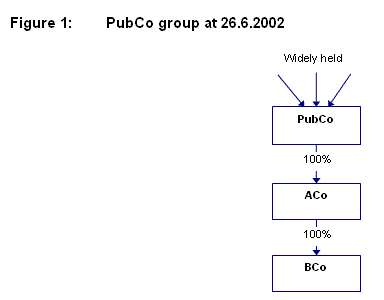Draft Taxation Determination
TD 2004/D64
Income tax: consolidation: does the continuing majority-owned entity test in subsections 701A-1(1) and 701A-1(2) of the Income Tax (Transitional Provisions) Act 1997 require tracing through interposed entities to the ultimate beneficial owners to determine whether there has been a change in the majority ownership of an entity during the period from 27 June 2002 until the entity becomes a subsidiary member of a consolidated group?
-
Please note that the PDF version is the authorised version of this draft ruling.This document has been finalised by TD 2004/88.
FOI status:
draft only - for comment| Preamble |
| This document is a draft for industry and professional comment. As such, it represents the preliminary, though considered views of the Australian Taxation Office. This draft may not be relied on by taxpayers and practitioners as it is not a ruling for the purposes of Part IVAAA of the Taxation Administration Act 1953. It is only final Taxation Determinations that represent authoritative statements by the Australian Taxation Office. |
1. Yes. In determining whether there has been a change in the majority ownership of an entity, it is necessary to trace through one of more interposed entities to the ultimate beneficial owners of the entity for the purpose of applying the continuing majority-owned entity test in section 701A-1 of the Income Tax (Transitional Provisions) Act 1997 (IT(TP)A 1997).
2. A 'continuing majority owned entity' is an entity that was majority (more than 50%) owned at all times by a person or persons from the start of 27 June 2002 until the entity becomes a subsidiary member of a consolidated group. This period includes the date the entity becomes a subsidiary member.
3. To avoid the integrity measures contained in sections 701A-5 and 701A-10 of the IT(TP)A 1997 applying to a joining entity's trading stock and/or internally generated assets, a joining entity must be able to demonstrate that there has been a change in its majority ultimate beneficial ownership. An entity unable to provide evidence of this change will be required to treat trading stock as a retained cost base asset and to give internally generated assets a dual cost base for income tax purposes.
Example
Majority beneficial ownership test (widely held ownership of head company)
Facts
4. As at 26 June 2002, PubCo, a publicly listed corporation on the Australian Stock Exchange, owns 100% of the shares in ACo, an Australian-resident company. On that date BCo, an Australian-resident company, is a wholly-owned subsidiary of ACo, and holds trading stock and internally generated assets.

5. On 31 December 2002, a hostile takeover of more than 75% of PubCo's listed shares takes place, resulting in a change in majority ownership of PubCo.
6. On 1 July 2003, PubCo forms a consolidated group comprising itself as head company with subsidiary members ACo and BCo.
7. There are no changes to PubCo's membership interests in ACo and ACo's membership interests in BCo from 26 June 2002 until the consolidation time of 1 July 2003.

Applying the test
8. On 31 December 2002, a hostile takeover of PubCo resulted in a change in ownership of PubCo at the ultimate beneficial ownership level. Although there has been no change in PubCo's ownership of ACo or BCo, the test for majority ownership in section 701A-1 of the IT(TP)A 1997 requires a 'bottom-up' tracing approach (through widely held or public companies, including publicly listed companies) to the ultimate beneficial owners to determine whether or not the integrity measures apply.
9. Given the change in majority beneficial ownership has taken place at the ultimate beneficial ownership level, PubCo, ACo and BCo do not qualify as continuing majority-owned entities. As a result, the integrity measures do not apply to BCo's trading stock and internally generated assets for the purpose of cost setting.
Date of Effect
10. When the final Determination is issued, it is proposed to apply both before and after its date of issue. However, the Determination will not apply to taxpayers to the extent that it conflicts with the terms of settlement of a dispute agreed to before the date of issue of the Determination (see paragraphs 21 and 22 of Taxation Ruling TR 92/20).
Your comments
11. We invite you to comment on this draft Taxation Determination. Please forward your comments to the contact officer by the due date.
| Due date: | 15 October 2004 |
| Contact officer details have been removed following publication of the final ruling. | |
Commissioner of Taxation
15 September 2004
Not previously issued in draft form
References
ATO references:
NO 2004/10517
Related Rulings/Determinations:
TR 92/20
Subject References:
Consolidation
Legislative References:
TAA 1953 Pt IVAAA
ITAA 1997 Div 705
IT(TP)A 1997 701A-1
IT(TP)A 1997 701A-1(1)
IT(TP)A 1997 701A-1(2)
IT(TP)A 1997 701A-5
IT(TP)A 1997 701A-10
Other References:
Explanatory Memorandum to the New Business Tax System (Consolidation and other measures) Bill (No. 1) 2002
Copyright notice
© Australian Taxation Office for the Commonwealth of Australia
You are free to copy, adapt, modify, transmit and distribute material on this website as you wish (but not in any way that suggests the ATO or the Commonwealth endorses you or any of your services or products).
